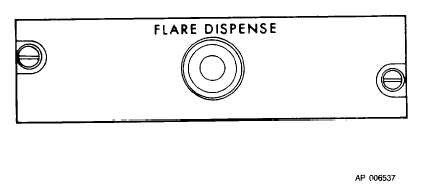TM 55-1510-222-10
Figure 4-2. Flare Dispense Switch
b.
Normal Operation.
NOTE
The fairing should be removed from
the fuselage if the aircraft is to be
flown
with
the
flare
dispenser
assembly removed.
(1) General. At the present time surface-to-air,
intermediate range guided missiles, launched against
the aircraft must be visually detected by the aircraft
crew. Crew members must ensure visual coverage over
the ground area where a missile attack is possible. The
aircraft radar warning system will only alert the pilot and
copilot when the aircraft is being tracked by radar-
guided anti-aircraft weapons systems. It will not indicate
the firing of weapons against the aircraft.
(2) Crew
responsibilities.
The
pilot,
or
designated crew member, is responsible for removing
the safety pin from the right wing before flight, and for
replacing it immediately after flight. After the aircraft is
airborne, the pilot is responsible for removing the safety
pin from the electronic module and moving the ARM-
SAFE switch on the dispenser control panel to ARM.
Before landing, he is responsible for re-inserting the
safety pin in the electronic module and moving the
ARM-SAFE switch to SAFE. While airborne, the pilot
and copilot are responsible for scanning the terrain for
missile threats. When either pilot recognizes a missile
launch, he will press the FLARE DISPENSE button to
eject flares.
WARNING
Aircraft must be in flight to dispense flares.
(3) Conditions for firing. The dispenser system
should not be fired unless a missile launch is observed
or radar guided weapons systems is detected and
locked on. If a system malfunction is suspected, aircraft
commander may authorize attempts to dispense flares
or chaff as a test in a non-hostile area.
(a) Firing procedure.
1.
Flares. Upon observing a missile
launch the pilot or copilot (whoever sights the launch
first) will fire a flare. If more than one missile launch is
observed, the firing sequence should be continued until
the aircraft has cleared the threat area.
4-4


